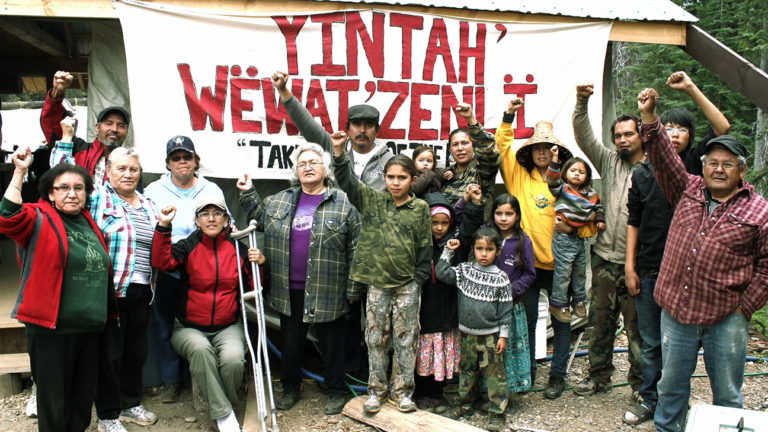- About
- Topics
- Picks
- Audio
- Story
- In-Depth
- Opinion
- News
- Donate
- Signup for our newsletterOur Editors' Best Picks.Send
Read, Debate: Engage.
| March 24, 2021 | |
|---|---|
| topic: | Indigenous people |
| tags: | #Canada, #indigenous rights, #Sinixt people, #colonialism, #conservation |
| located: | Canada, USA |
| by: | Frank Odenthal |
The Sinixt people are part of the Arrow Lakes Band, one of 12 tribes that make up the Colville Confederated Tribes.
Southeastern British Columbia is the traditional territory of the Arrow Lakes, or Sinixt, people. When an imaginary line was drawn across the continent in 1846 to separate Canada from the United States, it went straight through their territory. Many Sinixt people were pushed south and became residents of the United States. Now, they are fighting for their right to return to their ancestral land in Canada. The problem is: the Canadian Federal government declared them “extinct” in 1956.
But they are still there, and they want to keep their traditions alive. They want to return home.
FairPlanet spoke to Mark Underhill, the Sinixt's attorney, who represents them on their appeal in court.
FairPlanet: What does it mean to be declared “extinct“ from a legal perspective?
Mark Underhill: That‘s a very good question. Many years ago, some government officials went out and tried to group all sorts of First Nations people together into so-called bands. These bands sometimes had very little to do with their historical groupings or connections to other groups, which see themselves as part of a larger nation historically. It didn‘t respect the traditional structure and form of governance of the First Nations in Canada. They‘ve been divided into smaller groups. And that‘s what happened with the Sinixt.
So when the border between Canada and the US was drawn, many of the Sinixt were not living in Canada at the time these bands were set up. There was one band set up called the Arrow Lakes Band in the earlier parts of the 20th century. That band included Sinixt people, but also some people from other groups as well. And it was that Arrow Lakes Band that was declared extinct in 1956.
The government's position has been that there is no longer a group of Sinixt people [that] exist legally, if you want, that can hold constitutionally protected rights in Canada. They said the Sinixt have been legally extinct in Canada since at least 1956. And we say: hold on, you got it all wrong, there‘s still a group of people who are, as it‘s called “Aboriginal people of Canada“ under our constitution, and they can hold rights. And that‘s what we‘re fighting about. And as far as I‘m aware it‘s the first case, at least in North America, that you‘re actually fighting about whether or not a group exists anymore; whether they‘re extinct or not. So it‘s pretty remarkable.
So, they were actually just being declared “extinct” in Canada, no matter how many of the Sinixt still live in the US?
Yes, look, they were not saying they were gone, they say they just live in the United States now. They are now American citizens and no longer Canadians. They were shoved into that reservation arrangement back in 1872, but they are now Americans. For the provincial government at that time they were just a bunch of Americans, not Canadians that could have rights.
If it would have been the other way round, and the Sinixt would have been pushed from America into Canada, would the legal situation then be different? Which law is more in favour of First Nations rights?
There are different legal systems, sure, and they have different statuses in Canada versus the United States. In the US, or to be more specific, in Washington state, which is where the Colville reservation area is, [...] they fortunately have a much more sophisticated self-government than most of the First Nations in Canada were allowed to have. The Canadian Indian Act is fairly limited, there‘s still quite a bit of control by the provincial and federal governments.
They‘ve been treated quite badly in both countries, but, yes, there are still some differences.
Is there a certain Sinixt law, such as their traditional law or a law especially designed for the Sinixt people?
Yes. It didn‘t feature prominently in the case, though, but all First Nations have their own system of internal laws and governance. [B]ut it has been pushed aside by the governments on both sides of the border. But those governance structures are still there; it‘s just that they had problems operating within the legal system in Canada and the US.
The courts just haven‘t recognised them at all. So, we, the lawyers of the First Nations, are slowly getting the courts recognising those laws. Particularly when it comes to management of resources. The federal government and the provincial government have now taken charge of the management of resources, like wildlife and land. It‘s all about sustainability. They‘re required by their own laws to manage those resources in their territory for future generations.
That‘s a core point of all First Nations, including the Sinixt, because they were stewards of that land for thousands of years, and they are just trying to reclaim that role and shepherd those resources through, because their whole culture and identity [are] tied up with those resources. They have ties to their land that you and I just don‘t have.
But do the Sinixt at the same time see themselves as Canadians, too?
Absolutely, they do. Most of their territory, about 80 percent, was in Canada prior to 1846, when the border was officially introduced. So, they are more Canadian than I am - in a sense that they were there thousands of years before my ancestors arrived.
They consider themselves just as Canadian as I do. They happen to have American citizenship, but their very identity is defined by the fact that they are from Canada. They‘re from that territory that is now in Canada. That‘s what it means to be Sinixt: to be from that part of the world. No matter if they live in big cities now, they always have to reconnect and get back to their traditional grounds and practice their traditional rituals. And right now they‘re not able to do that, as it‘s been illegal for them to do that.
Last year the Sinixt went to court again with their issues. What happened there?
Well, we‘ve been now through four levels of court. It started at what was called the Provincial Court of British Columbia, then at the BC Supreme Court, that was round two, and then round three was the BC Court of Appeal. And [we’ve] won every round. And the last appeal, from the BC Court of Appeal, was to the Supreme Court of Canada. That‘s the hearing that was argued on 8 October of 2020.
And that‘s the last stage of the case, the final appeal. So, what the Supreme Court of Canada says is the last word for the Canadian courts.
And what did it say?
They haven‘t said anything yet. We showed up and made our legal arguments, some people were there by person, some were there by video conference. But the bottom line is, what we call in Canada, the court has reserved judgement. So we‘re waiting for their decision, and that will come at some point later this year.
What do you expect their decision will be?
My impression was that we‘ve got a good hearing, and I think most of the observers at the hearing are forecasting that we will again prevail.
You know, what people have to prove in such a case is they have to show that you were there. The Aboriginal people of Canada - they have rights, they have protected rights in Canada, protected by our constitution. But you have to show that your people were living there as an organised society prior to the arrival of Europeans. And that‘s not an easy burden! It won‘t be a stampede of people claiming rights in Canada, just because it‘s not easy to prove.
If you live for decades in, say, California, then it‘s not easy to prove your rights in Canada. And that‘s what the court is thinking about right now: what are the implications? What does it mean? What will happen then? Will American citizens be able to come to Canada and claim certain rights? That‘s an interesting question. And the answer to that question is yes. Because of that history, because of that deep connection to Canada.
A bizarre detail of that court hearing was that the case was to prove that the Sinix people are not extinct. But they were not allowed to enter the court and show themselves.
Well, that was a very, very unfortunate consequence of the pandemic. Normally, the courtroom is packed, and we had plans to bring quite a number of Sinixt people into the court house. But we couldn‘t do that because of the coronavirus restrictions.
To what extent does the public in Canada pay attention to the case?
I‘m not sure about how the average person pays attention to it. But I can tell you that it is the subject of considerable interest for First Nations and people who are interested in these issues in Canada.
It received a great deal of media attention across the country, because it does have implications for First Nations across the country because, you know, we have quite a long border between Canada and the United States, and all along that border there are First Nations who historically and traditionally lived their lives in practice on both sides of the border.
Mark G. Underhill is a 1995 graduate of the Faculty of Law, University of Victoria, and was called to the Bar of the Law Society of British Columbia in 1996. He practised with Arvay Finlay for ten years before establishing his own firm in 2005. In 2017, Mark reconstituted Arvay Finlay with Joseph J. Arvay and other former members of the firm. He has appeared regularly for the Environmental Appeal Board, Forest Appeals Commission, BC Review Board, the British Columbia Human Rights Tribunal and the Office of the Police Complaint Commissioner. He has been selected by his peers to be included in Best Lawyers in Canada in the areas of aboriginal law, administrative and public law, and environmental law, and is L’expert rated in the areas of environmental and aboriginal law.
Image: Judith Gandy.
By copying the embed code below, you agree to adhere to our republishing guidelines.


